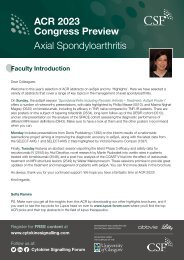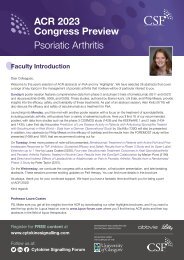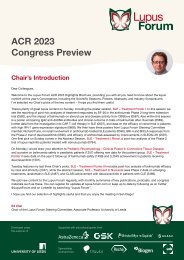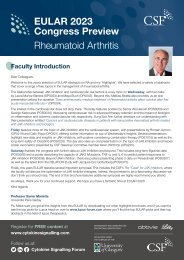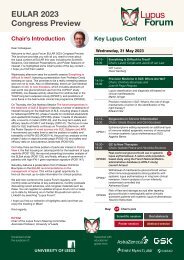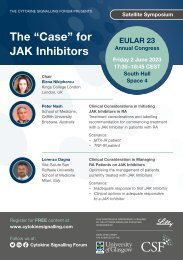ACR Congress Review 2019
You also want an ePaper? Increase the reach of your titles
YUMPU automatically turns print PDFs into web optimized ePapers that Google loves.
At 6 months post-switch, patients switched to adalimumab achieved 69%, 37%, 16% improvements in<br />
<strong>ACR</strong>20/50/70 responses, and 40% and 21% achieved DAS28-CRP≤3.2 and ≤2.6. Patients switched to<br />
upadacitinib achieved 81%, 56%, 32% improvements in <strong>ACR</strong>20/50/70, and 56% and 35% achieved<br />
DAS28-CRP≤3.2 and ≤2.6 at 6 months. Mean changes from the original baseline in HAQ-DI were -0.58<br />
and -0.73 for patients switching to adalimumab and upadacitinib, respectively. The proportions of<br />
patients with infection and serious infection through 6 months post-switching appeared consistent with<br />
those observed for adalimumab and upadacitinib during comparable periods. The authors concluded<br />
that patients with initial non-response to either upadacitinib or adalimumab can benefit from switching to<br />
the other therapy [2907*].<br />
Effects of upadacitinib on reverse cholesterol transport<br />
Charles-Schoeman and colleagues presented findings on the effect of upadacitinib treatment on<br />
cholesterol efflux capacity (CEC) and the association of CEC with changes in inflammation and serum<br />
lipids using data from a subset of patients in the BALANCE II and SELECT-NEXT studies. In both<br />
studies, changes in global and ABCA1-dependent CEC, and to a lesser extent non-ABCA1-dependent<br />
CEC, were significantly higher in the upadacitinib-treated group compared with the placebo group. Thus,<br />
upadacitinib treatment was associated with significant improvement in CEC. This effect was observed<br />
even among those demonstrating minimal clinical response (but not in those treated with placebo). The<br />
effect seemed to be primarily driven by ABCA1-dependent cholesterol efflux and is strongly correlated<br />
with a rise in HDL cholesterol as well as reduction in systemic inflammation as measured by change in<br />
CRP levels [510].<br />
Normalisation of key pathobiological pathways in upadacitinib-treated patients<br />
A poster on the mode of action of upadacitinib in patients with RA was presented by Sornasse et al. The<br />
authors used a proteomic approach to evaluate a set of plasma proteins associated with inflammation in<br />
randomly selected plasma samples from patients in the SELECT-NEXT and SELECT-BEYOND studies<br />
(placebo, n=167; upadacitinib 15 mg QD, n=200). Consistent with its selectivity for JAK1, upadacitinib<br />
was found to operate via inhibition of multiple JAK1-dependent upstream pathways that result in the<br />
normalisation of key functional downstream effects associated with the pathobiology of RA, including<br />
T cell and myeloid cell-related pathways. It was also noted that non-JAK signalling pathways were also<br />
normalised, suggesting functional integration of JAK1 with parallel pathogenic signalling in RA effector<br />
cells [522*].<br />
Upadacitinib MOA assessed by genome-wide RNA expression<br />
Lent and colleagues presented a poster on upadacitinib mechanism of action as assessed by<br />
genome-wide RNA expression. Whole blood samples were analysed from a subset of patients from the<br />
SELECT-NEXT study (upadacitinib 15 mg QD, n=99; placebo, n=100). Analysis of the top 100 most<br />
affected transcripts by upadacitinib at Week 2, Week 4, and Week 12 identified modest but highly<br />
significant modulation of a set of genes known to be differentially expressed in RA peripheral blood.<br />
mRNA associated with B and T lymphocytes were increased, while mRNA associated with neutrophils<br />
and monocytes were decreased, likely reflecting (at least in part) changes in leukocyte recirculation.<br />
Pathway analysis demonstrated a broad inhibitory effect by upadacitinib on cytokines associated with<br />
the pathobiology of RA, on intracellular signalling, and on toll-like receptor-pathways. Similarly, pathways<br />
related to both innate and adaptive immune activation, leukocyte movement, phagocytic cell activity, and<br />
leukocyte adhesion were predicted based on mRNA modulation, to be inhibited by upadacitinib.<br />
Reciprocally, pathways associated with the numbers of B, T, and haematopoietic cells were predicted to<br />
be activated by upadacitinib. In summary, upadacitinib normalizes key pathobiological pathways in RA<br />
consistent with its clinical effect [545*].<br />
*Chairman’s Pick



